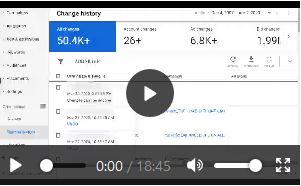
If you’re already running AdWords campaigns, you know that Google makes a huge amount of data accessible to you surrounding the performance of your campaigns. While it can feel overwhelming to wade through a dashboard full of numbers and metrics without purpose, learning to parse your AdWords dashboard effectively can give you a wealth of insight into how your campaigns are running, and what you can do to make them more successful.
Most people don’t have time to sit down and pore over stacks of data, so paying close attention to the right metrics will let you get the information you need to run your campaigns well without wasting valuable time. Here are five of the most important metrics that you should always monitor in AdWords, and how they can help you make your PPC campaigns more successful.
Table of Contents
CTR (Click-Through Rate)
Your CTR, or click-through rate, is one of the basic building blocks of AdWords analytics. Because CTR only measures how many clicks your ads receive, it doesn’t paint the complete picture of how your campaigns are performing. However, that doesn’t mean that you should ignore your CTR. While CTR isn’t very useful for determining overall conversions, it is an important indicator for whether your ads are reaching the right audience.
Successful advertisers treat CTR as a litmus test for whether their ad copy is on-point and if they’ve chosen the appropriate keywords. Oftentimes, a drop in CTR can be a sign that it’s time to freshen up your ad copy or rethink their keyword strategy.
Conversion Rate
CTR is a useful metric for knowing whether your ad copy and keyword strategy is up to par, but your conversion rate is an important metric because it tells you what happens after that first click. Whether a conversion means filling out a form on a landing page, making a purchase or calling your business, measuring how many of your viewers “convert” to qualified leads or customers helps you understand the overall success of your PPC efforts. Your conversion rate can tell you how well your advertising campaigns are truly reaching potential customers.
A good conversion rate is proof that your ad spend is leading to real profit, and thus that your investment in PPC advertising is (literally) paying off. If your CTR is high but your conversion rate is low, you may need to consider reviewing your landing page, or examine whether your ads are reaching the right segment of your audience.
CPC (Cost Per Click)
Paying close attention to your CPC, or cost per click, helps you allocate your budget more effectively and ensures that high-cost keywords aren’t eating up your ad spend too quickly. In industries such as insurance and legal, where competitive keywords can be extremely costly, ensuring that your cost per click stays reasonable is an important safeguard against overspending for ad placements.
Managing cost per click can be a fiddly business, as the baseline cost per click can vary dramatically for some keywords depending on the time of day, your Quality Score, and a variety of other factors. Many advertisers opt to have their campaigns managed by PPC management firms like Webrageous or use automated bidding tools in order to maximize their cost per click.
Cost Per Conversion
Just as CTR is a weak metric without the context of your conversion rate, CPC can be much more valuable if it is considered alongside your cost per conversion. Cost per conversion indicates what the cost of acquiring a conversion or new customer is. A healthy cost per conversion should correspond to the overall value that a conversion brings. For example, an online clothing retailer selling $5 pairs of socks would not want to pay $50 per conversion, but for a lawyer that $50 conversion may result in thousands of dollars income in the long run.

Need Google Ads Management Help?
Free Google Ads account review for
qualified clients
Almost 20 years experience
Cost per conversion gives you insight into the ultimate value of your PPC campaigns. Just as with conversion rate, examining your cost per conversion can help you understand the real financial benefit that your ad campaigns are bringing to your company.
Quality Score
While Quality Score can feel a little more mysterious than other metrics, it impacts everything from how much you pay for ads to how good their placement is, so it’s a critical metric to monitor in AdWords. The other metrics we’ve discussed have to do with how your audience views and reacts to your ads. Quality Score is an important indicator of what Google’s algorithm thinks of your ads. And since Google is the gatekeeper of ad performance, making sure that your ad copy, keyword strategy and landing pages live up to Google’s standards can help you get the best results for your campaigns.
Whenever you make changes to your campaigns — especially if you make changes to your ads and landing pages, make sure that you double check your Quality Score. Making changes to copy and layout can have a significant impact on your Quality Score, which can ripple through other aspects of your campaigns and bring down performance quality.
Running Data-Driven AdWords Campaigns with Webrageous
PPC is a fast-moving, ever-changing advertising medium. As demand for online advertising continues to rise and the tools used to run campaigns become more sophisticated, being able to monitor and interpret key metrics for your ad performance can have a huge impact on your advertising success. By using metrics to drive your advertising decision-making process, you’ll be able to react to any changes and make PPC decisions based on data, rather than blindly making choices that may or may not improve your campaigns.
Webrageous has been running data-driven PPC campaigns for our clients for years, and we can give you more insight into your AdWords metrics to help you run your advertising campaigns more effectively than ever. Contact us today for more information on running high-performing AdWords campaigns with Webrageous.



















